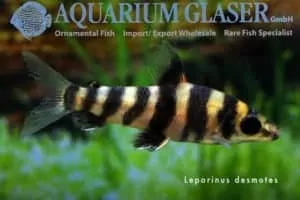Otocinclus arnoldi
Otocinclus arnoldi was officially described by Regan in 1909. This species belongs to the Loricariidae family or the Armored Catfish.
The name Otocinclus can be broken down into two words. Ous, oto comes from ancient Greek and means ear. Cinclus comes from Latin and means latticework, a reference to the holes in the head for the ears. The species name arnoldi is a reference to the person who donated this species for research: J.P. Arnold.
This species was for a while considered a synonym of Otocinclus flexilis, but that was based on incorrect assumptions. In 2010 the species was restored by Lehmann, Mayer and Reis.
Description
Otocinclus arnoldi can reach a maximum length of about 5 to 6 centimeters. The body is somewhat flattened in height.
The base color may vary somewhat from grayish brown to yellowish brown. You will see brown spots on the upper half of the fish at the front and head. Further back, this species has three to six wide vertical brown bars on the upper half, so-called saddles.
The front ray of the dorsal fin is dark and the rest is somewhat lighter. This also applies to the pelvic fins. The anal fin is almost completely transparent but shows some dark spots on the front fin ray. The caudal fin is transparent with dark brown spots. The belly is cream colored.
Otocinclus arnoldi differs from all other Otocinclus species except Otocinclus mimulus in that they have five fin rays in the pectoral fin compared to six in the other species.
Origin
The habitat of Otocinclus arnoldi is in South America and is limited to the catchment area in the lower reaches of the Rio Paraná, middle and lower reaches of the Rio Uruguai and the Rio de La Plata. This area is located in Argentina, Brazil and Uruguay.
They inhabit the densely planted parts of the banks.
Diet
Otocinclus arnoldi searches for something edible among the densely planted banks. Here they mainly graze among the algae (aufwuchs). They are therefore herbivores that only occasionally ingest some animal food in the form of micro-organisms that live between the algae strands.
In the aquarium they will look for algae among the plants. If you feed them you can give them vegetable food such as spirulina flakes, spinach, lettuce, etc. Some small live food now and then is fine.
The Aquarium
Furnish the aquarium with (filter) sand on the bottom. Provide plenty of plants and a moderate current. Otocinclus arnoldi will be seen among the plants as it cleans the leaves of algae. Use an aquarium from about 80 centimeters so that a group can find enough algae to live on.
The water may have a temperature of about 16 to 25 degrees Celsius. Do not keep them at the extreme values all year round. The 16 degrees is the winter temperature and can therefore be a bit higher in the summer. The pH may be between 5 and 7 with a GH of about 4 to 12.
Breeding Otocinclus arnoldi
As far as is known, breeding of Otocinclus arnoldi in the aquarium has not yet been successful. All animals offered for sale should therefore be wild-caught. They are therefore not often offered in stores.
In the wild they only breed for a season. The eggs are stuck to a leaf. The parents show some brood care by protecting the eggs. The eggs hatch after three days.
Author
John de Lange
Copyright images
Chucao – CC BY-SA 3.0
References
Re-validation of Otocinclus arnoldi Regan and reappraisal of Otocinclus phylogeny (Siluriformes: Loricariidae)
Fischlexikon.eu
Fishbase.org








Reviews
There are no reviews yet.